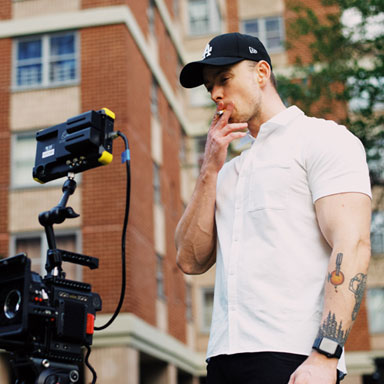- Home
- /
- Sergio Clemente – great screenplays mean...
Sergio Clemente – great screenplays mean great movies!
Why are scripts so essential in filmmaking?
When I think about script (screenplay) I’m reasoning on the foundations (script) on which a building will be built (film productions). And here’s the greatest value of a script: being the basis of a film; a story told through the images.
Now, let’s unravel what a movie script is…
A movie script is everything you see and hear in a movie. Example: scenes, dialogues. Everything is conceived, thought out, elaborated by the screenwriter (scriptwriter). Her or he is a writer to the movies. It’s a type of literature (script) made for the cinema. So, what’s the difference between writing a book (novel) and writing a script?
Literature (novel) is more extensive, complete, not condensed. You can pass a few pages describing the environment, or several chapters talking of a character. In the literature (script), you need to sum up everything. You have to show a lot of information in a short period (the length of the film). You have to introduce the character and the story in less than 30 pages if it is, by example, 120-pages script (2 hours) inside the style (Paradigm – American Cinema). The script is fully summarized, compact, concise, in relation to the literature (novel).
How is an adaptation made?
Adapting a literary work to the cinema, for example: a novel, it’s not a task easy. If the book has the characteristic of being complete and not summarized. The script is already the opposite of that. So the screenwriter will choose two or three elements of the work that he considers the essence of the (novel) and will work on cinematographic language these elements. It’s Adaptation.
What is an original script?
That’s when you – screenwriter – create, build a story (it can be true too), that has never been edited before: there’s nothing officially written about it. Your script will be the first work edited.
If a novelist wants to make a book from an original script, can she or he, do it?
Yes. It’s not very common. But it can happen. The normal thing is to run the opposite way: the adaptation of a book to movie screens.
Can a screenwriter work together with another screenwriter?
Yes. They can form a duo, trio or quartet. For example: one takes care of the preparation of scenes, the other of the dialogues, and the other two of the research – collecting data to enrich the script.
Who is more important? The Screenwriter or the Film Director?
While the script is being prepared, it is the screenwriter who commands everything. When the script goes into production (filming), the director is the ultimate authority. In that moment, the two can work together, making small adjustments when shooting. But the final word is from the film director.
How many days or months does it take to write a script?
If it’s a standard 120-minutes feature film, that it’s equivalent to two hours (each page of the script equals 1 minute), 3 to 6 months. If there is a full research paper, it could take two years or more. It depends on how many hours a day the screenwriter will work as well. But there are cases of screenwriters who manage to write a feature film in 40 days.
How can we judge whether a script is good or bad?
If the script hasn’t been produced yet… An expert will be able to evaluate and say if the screenwriter’s job is well done. In US, there are specific professionals who analyze scripts – before they are produced – on the entire aspects: commercial and artistic. If the script has already been produced, then the critic comes into play, who will be able to assess whether the script is good; if it has plot: let the story flow naturally or not.
Is it possible to make a good movie from a bad script?
The answer is no. Even if the director is excellent. The cast (actors) is great and we have several special effects…
All this will fall apart if the script is not good. That’s why we often see great actors in movies that aren’t so good. And then we ask ourselves “Why did she or he agree to make this boring movie?”. It’s about business too, right? In the same proportion, It also becomes more difficult to spoil a movie from a good script. Therefore, the script is extremely essential in a film production. It is the basis of all the work that will be built until the film is completely finished.
Let’s imagine a Symphony Orchestra… It will perform a piece by BACH. So, we have: The Composer (Johann Sebastian Bach) equals the screenwriter; The Maestro equals the director; The Musicians equals the entire professionals involved in the production; Soloists equals the actors and main actresses. They all have to be in perfect harmony for the piece (the film) to be executed perfectly.
sergio clemente.
Let’s go to see two great styles of filmmaking and how one influenced the other: Dramatized Idea (European Cinema) and Paradigm (American Cinema).
I remember now with sweet memories of the teachings of my mentor Syd Field “It’s not exactly the story you’re telling the audience that makes the difference, but the way (form) that you tell your story that makes it the entire distinction”.
Exactly. You can tell the story of Hansel and Gretel lost their way in the forest (fairy tale) by brothers Grimm in a hundred ways (forms) without losing the essence of the story.
Let’s check it out on that two great styles (ways–forms) to tell the stories that blows the minds of so many filmmakers around the world.
Dramatized Idea (European Cinema)
The main features of this style are:
1) Characters work on the idea and they can be discarded at any time to emphasize the idea.
2) The Idea drives the characters.
3) The Idea is the main character.
4) Open endings – Unexpected.
5) Little or no dialogue.
Great filmmakers have represented this style well: Jean Renoir, Jean-Luc Godard, Federico Fellini, Vittorio De Sica, Ingmar Bergman, François Truffaut, Jean-Pierre Jeunet, Charlie Chaplin, Fritz Lang, Bernardo Bertolucci, Sergei Eisenstein, Luis Buñuel, Lars Von Trier and others.
Now we can see a scene that represents this style very well:
Let’s imagine that we – the audience – are the eyes – the camcorder – of the filmmaker. So, we visualized an abstract painting on the wall of a living room in any apartment. Then, slowly, we notice that there is a man dressed in a suit without tie, sitting in a green armchair. He smokes a cigarette and seems to be very calm. Our camcorder (our eyes) stays on him for some time.
After that, a woman, in a quite elegant green dress, passes in front of the camcorder (our eyes) carrying a small suitcase. She places the suitcase beside the other empty armchair and sits down.
We realize that neither she nor the man looks at each other. Slowly the woman nods in the opposite direction from which the man is sitting.
Then, the camcorder (our eyes) starts to move away from the two and we notice that there is a fan turned on in the corner of the wall next to the man. The fan moves left to right and right to left and at this point it’s the only thing that’s moving in the living room. Suddenly, the woman gets up, takes her small suitcase and without looking at the man leaves.
Now let’s think with the filmmaker’s head… What does he want to tell us with this wonderful scene? The answer is in just one word: separation (the idea). That’s it. The dramatized idea behind this scene is: a couple who are divorcing and therefore have fought, argued, put their points of view, said everything they wanted to say to each other and the decision has already been made… The woman left.
Paradigm (American Cinema)
The main features of this style are:
1) Usually one or two characters lead the story.
2) Act I – introduces the story and character.
3) Act II – conflicts occur.
4) Act III – the resolution of these conflicts.
5) Characters back modified – The journey of the hero.
Let’s take the same scene that we described in the previous style (dramatized idea) and see what it would look like in the paradigm.
The camcorder (our eyes) watches a suitcase that is thrown open on the bed. Then, a handful of clothes is loaded into the suitcase. The man approaches the open bedroom door: “What are you doing?” A woman packs her suitcase aggressively. “I’m leaving. Our marriage is over.” He takes her arm and tries to make her give up. “You can’t do this. I know we love each other and you’ll regret it.”
She faces him “You’re a tramp who doesn’t want to work. I didn’t get married to support you.” She picks up her suitcase and heads towards the living room. He follows her and tries to stop her once more. “Please don’t go. I’m going to look for a job.”
She opens the entrance door and walks down the stairs towards the street. “You always say that. I’m sick of you.” A taxi is waiting. She gets in the car and leaves.
Great filmmakers have represented this style well: Steven Spielberg, George Lucas, Francis Ford Coppola, James Cameron, Martin Scorsese, Sergio Leone, Clint Eastwood, Oliver Stone, Robert Zemeckis, Peter Jackson, Ridley Scott, Ron Howard, Christopher Nolan and others.
Which style do you like best? If you liked both and want to pursue a career as a screenwriter or film director, know that you can mix (blended) the two models and develop your own way to tell a story through the images. Remember that the last word in cinema has not yet been given. Even great filmmakers are always learning something new.
Now let’s look at some filmmakers who represent this mix well: Orson Welles, Alfred Hitchcock, Akira Kurosawa, Frank Capra, David Lean, Stanley Kubrick, Woody Allen, David Lynch, Luc Besson, Quentin Tarantino, Spike Lee, Joel and Ethan Coen, Pedro Almodóvar and others.
sergio clemente.
Movies in Lagos
Shooting in Lagos is my business I have worked on many of a California movie set,...
Topmost African Screenplay Writer
About Abasseno Uko I have learned that those who know where they are going at a...
FOLLOW US ON INSTAGRAM @moviesbyespresso




